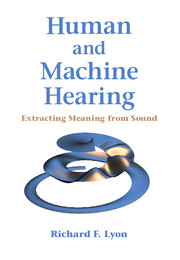Book contents
- Frontmatter
- Dedication
- Contents
- Foreword
- Preface
- Part I Sound Analysis and Representation Overview
- 1 Introduction
- 2 Theories of Hearing
- 3 On Logarithmic and Power-Law Hearing
- 4 Human Hearing Overview
- 5 Acoustic Approaches and Auditory Influence
- Part II Systems Theory for Hearing
- Part III The Auditory Periphery
- Part IV The Auditory Nervous System
- Part V Learning and Applications
- Bibliography
- Author Index
- Subject Index
- Plate section
5 - Acoustic Approaches and Auditory Influence
from Part I - Sound Analysis and Representation Overview
Published online by Cambridge University Press: 28 April 2017
- Frontmatter
- Dedication
- Contents
- Foreword
- Preface
- Part I Sound Analysis and Representation Overview
- 1 Introduction
- 2 Theories of Hearing
- 3 On Logarithmic and Power-Law Hearing
- 4 Human Hearing Overview
- 5 Acoustic Approaches and Auditory Influence
- Part II Systems Theory for Hearing
- Part III The Auditory Periphery
- Part IV The Auditory Nervous System
- Part V Learning and Applications
- Bibliography
- Author Index
- Subject Index
- Plate section
Summary
Machines which automatically recognize patterns from a stream of acoustic events, for example a spoken command, would have great utility in both communications and data processing. This paper reviews two applications of an elementary recognizer to the problem of actuating certain logical functions, and indicates how more ambitious recognizers might be utilized. In this regard, the automatic measurement of a talker's voice pitch and voicing dynamics appears fundamental to speech analysis, and hence to many recognition schemes. Visual inspection of spectral data taken from different speakers supports this contention.
—“Artificial auditory recognition in telephony,” E. E. David (1958)Sound, Speech, and Music Modeling
The sound analysis approach most commonly used in speech and music processing systems is to extract features of sound sources based on models of their acoustics, in a “front-end” process that is somewhat tuned with respect to properties of the auditory system. The presumption is that a description of the vocal tract or musical instrument that produces a sound can be reliably extracted from the sound waveform, and that such a description is very informative about the underlying speech or music communication intent.
The extraction of representations of sound sources works better when the analysis respects some of the basic properties of human hearing, such as the varying widths of critical bands with respect to frequency. All of the techniques commonly used to compress, code, or recognize speech or music have evolved to incorporate at least some influence from models of hearing. This approach—acoustic analysis influenced by hearing—stands in contrast with our more explicit hearing approach: the hearing approach is to model the kind of signal representation that the ear sends to the brain, for arbitrary sound types and sound mixtures, and to defer the interpretation into sound source features to later higher-level processes.
Although these approaches are differently motivated, they do share some conceptual basis. Understanding the nuances of the hearing approach will be easier once the acoustic approach is understood as a baseline.
- Type
- Chapter
- Information
- Human and Machine HearingExtracting Meaning from Sound, pp. 78 - 94Publisher: Cambridge University PressPrint publication year: 2017



